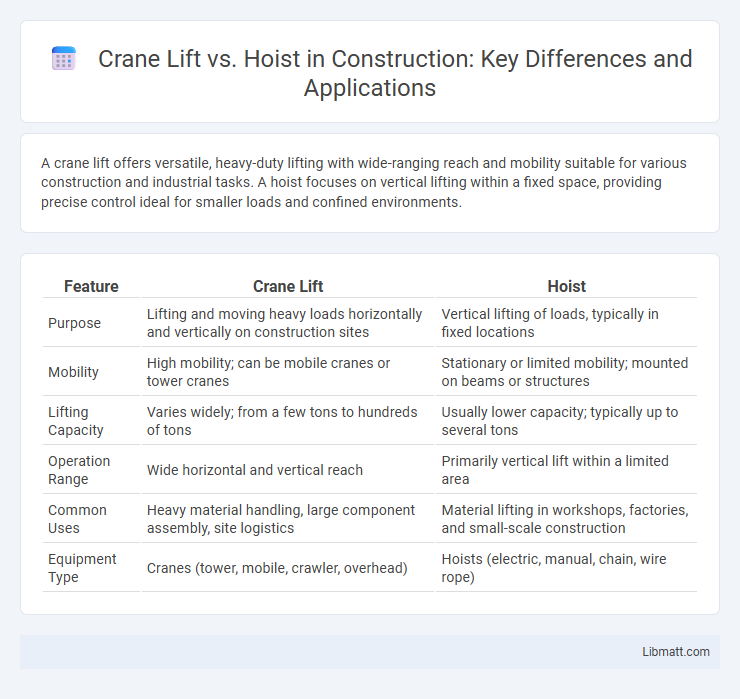A crane lift offers versatile, heavy-duty lifting with wide-ranging reach and mobility suitable for various construction and industrial tasks. A hoist focuses on vertical lifting within a fixed space, providing precise control ideal for smaller loads and confined environments.
Table of Comparison
| Feature | Crane Lift | Hoist |
|---|---|---|
| Purpose | Lifting and moving heavy loads horizontally and vertically on construction sites | Vertical lifting of loads, typically in fixed locations |
| Mobility | High mobility; can be mobile cranes or tower cranes | Stationary or limited mobility; mounted on beams or structures |
| Lifting Capacity | Varies widely; from a few tons to hundreds of tons | Usually lower capacity; typically up to several tons |
| Operation Range | Wide horizontal and vertical reach | Primarily vertical lift within a limited area |
| Common Uses | Heavy material handling, large component assembly, site logistics | Material lifting in workshops, factories, and small-scale construction |
| Equipment Type | Cranes (tower, mobile, crawler, overhead) | Hoists (electric, manual, chain, wire rope) |
Introduction to Crane Lifts and Hoists
Crane lifts and hoists are essential equipment used for lifting and moving heavy loads in construction, manufacturing, and warehousing. A crane lift typically involves a large machine with a boom, capable of moving loads vertically and horizontally over a wide area, while hoists are mechanical devices designed primarily for vertical lifting using a rope, chain, or cable system. Understanding the specific functions and applications of your crane lift or hoist ensures safe and efficient material handling tailored to your operational needs.
Defining Crane Lifts: Key Functions
Crane lifts are mechanical devices designed to raise, lower, and move heavy loads horizontally, often used in construction and manufacturing. They feature a combination of hoists, wire ropes, or chains operated by electric, hydraulic, or pneumatic systems to handle precise and heavy lifting tasks. Understanding the key functions of crane lifts helps you select the appropriate equipment for complex material handling and load distribution challenges.
Understanding Hoists: Types and Applications
Hoists are essential lifting devices used to raise and lower heavy loads vertically, with common types including electric, manual, and pneumatic hoists designed for various industrial applications. Your choice depends on load capacity, speed, and operating environment, as electric hoists offer efficiency for repetitive tasks while manual hoists provide cost-effective solutions for lighter loads. In comparison to cranes, hoists typically offer simpler installation and operation but are limited to vertical lifting rather than horizontal movement.
Core Differences Between Cranes and Hoists
Cranes are large, complex machines designed to lift and move heavy loads horizontally and vertically over significant distances, typically used in construction and industrial settings. Hoists, in contrast, are specialized devices primarily for lifting or lowering loads vertically within a fixed or limited range, often integrated into cranes or used independently for smaller scale tasks. Understanding your project's scope and load requirements helps determine whether a crane or hoist is the optimal choice for efficiency and safety.
Lifting Capacity and Load Handling Comparison
Crane lifts generally offer higher lifting capacities compared to hoists, making them suitable for heavy-duty industrial applications requiring the movement of large loads. Hoists are designed for precise load handling with moderate capacities, often used in smaller-scale or confined environments where controlled lifting is essential. Your choice between crane lift and hoist will depend on the specific weight and handling requirements of your project.
Safety Features: Crane Lifts vs Hoists
Crane lifts offer advanced safety features such as overload protection, anti-sway control, and emergency stop systems, ensuring secure handling of heavy loads in construction and industrial environments. Hoists, while generally simpler, incorporate safety mechanisms like load limiters, thermal protection, and emergency brakes to prevent accidents during vertical lifting tasks. Your choice between a crane lift and a hoist should consider these safety features in relation to the specific operational demands of your lifting application.
Installation and Maintenance Considerations
Crane lifts require professional installation due to their complex structural components and load-bearing requirements, ensuring safety and compliance with industry standards. Maintenance of crane lifts involves regular inspections of the mechanical, electrical, and structural parts to prevent downtime and extend lifespan. Hoists offer simpler installation, often mounted on existing structures, with maintenance focusing on lubrication, brake checks, and cable or chain inspections for optimal performance.
Typical Use Cases for Cranes and Hoists
Cranes are typically used for lifting and moving heavy loads over long distances and at significant heights in construction sites, shipyards, and manufacturing plants. Hoists are designed for lifting or lowering loads vertically in confined spaces, such as warehouses or assembly lines, providing precise load control. Your choice between a crane and a hoist depends on the required load capacity, range of motion, and work environment.
Cost Analysis: Investment and Operating Costs
Crane lifts typically require a higher initial investment due to their complex structure and greater load capacity, while hoists offer a more cost-effective solution for lighter lifting tasks. Operating costs for crane lifts are generally higher because of maintenance, energy consumption, and the need for skilled operators, whereas hoists have lower upkeep expenses and simpler operation requirements. Your choice should balance the upfront investment and ongoing expenses against the specific lifting demands of your project.
Choosing the Right Equipment for Your Needs
Selecting between a crane lift and a hoist depends on the weight, height, and mobility requirements of your project. Crane lifts offer greater vertical reach and versatility for transporting heavy loads horizontally across a workspace, while hoists excel at lifting and lowering heavy objects in fixed positions with precision. Evaluating your specific load capacity and site layout ensures you choose equipment that maximizes efficiency and safety.
Crane lift vs hoist Infographic

 libmatt.com
libmatt.com